#dybbuk
Explore tagged Tumblr posts
Text
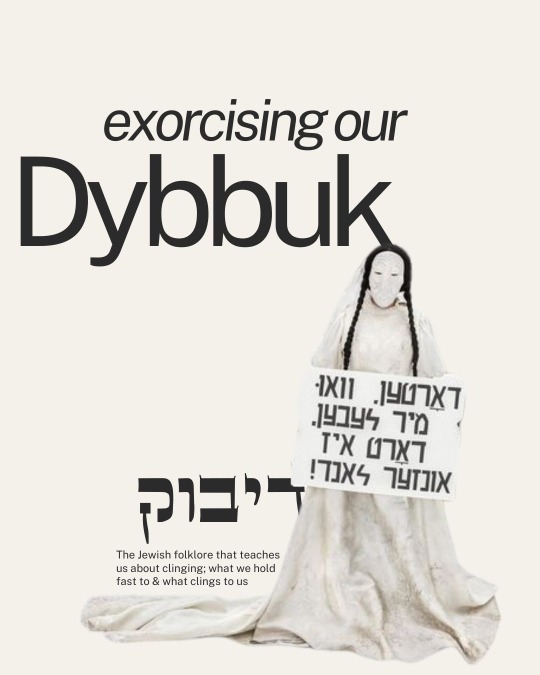
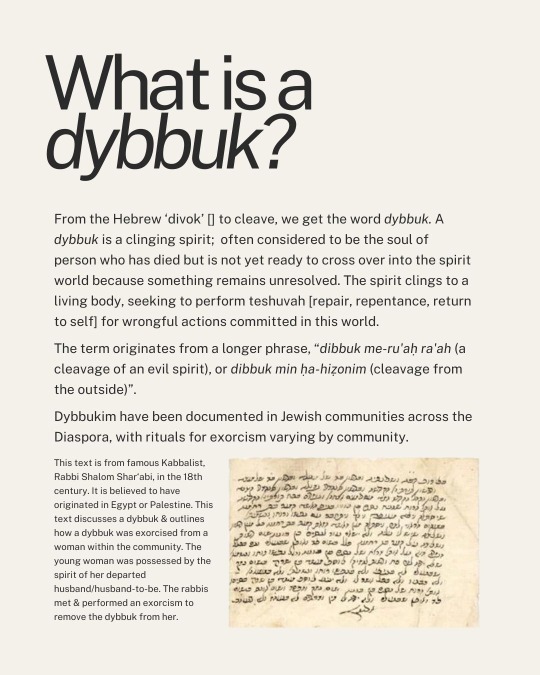
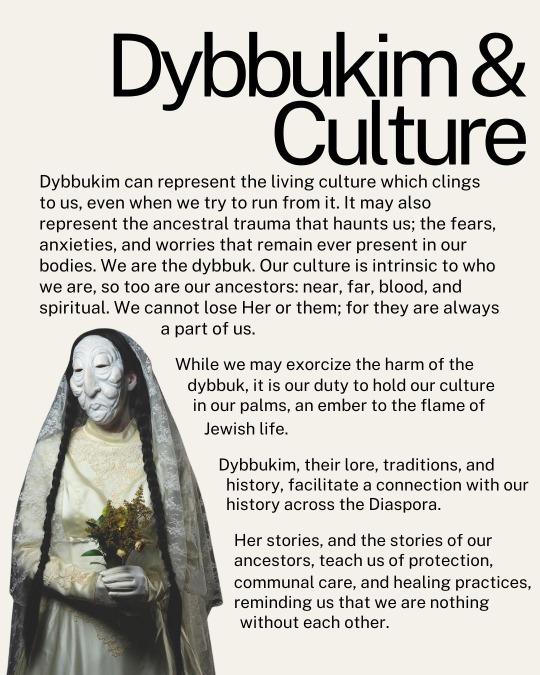



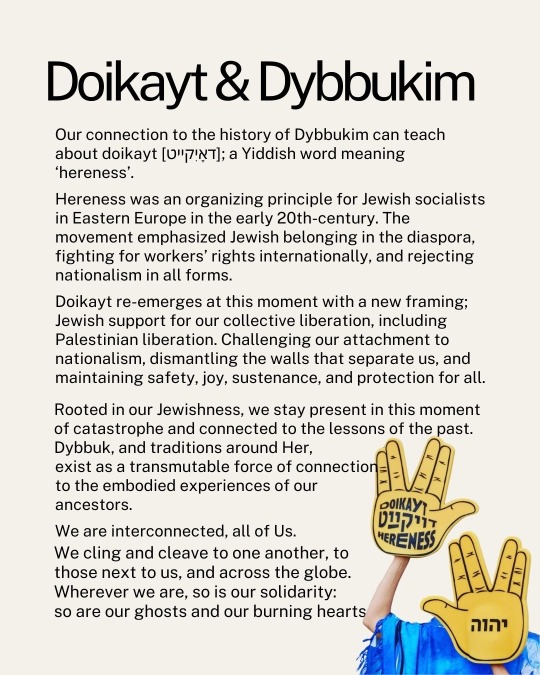
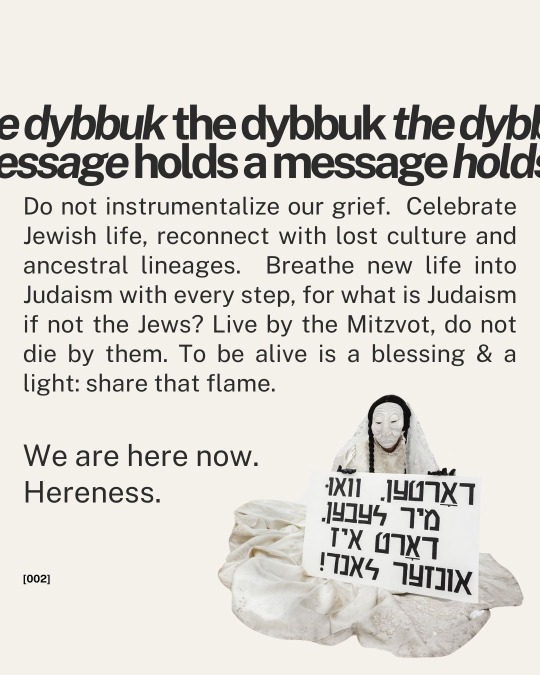
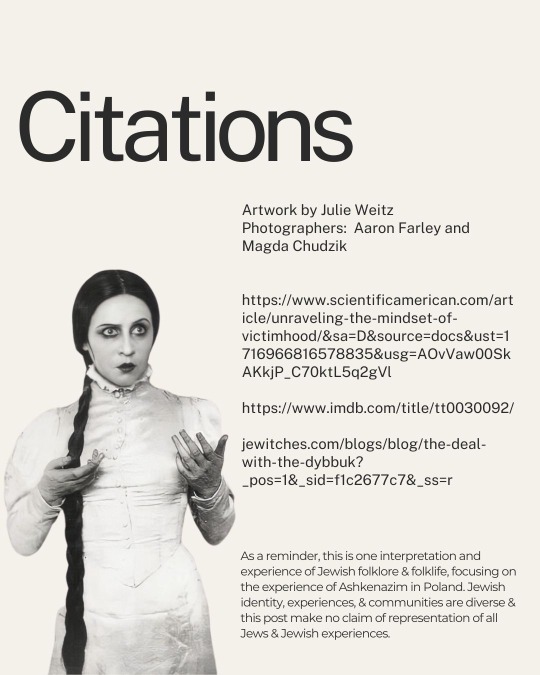
What are Dybbukim? How can we interpret our tradition surrounding them during this fraught moment, as Jewish communities cling to and cleave from tradition, spirituality, and ḥesed (loving-kindness)?
What are our dybbukim?
How does the tradition of Dybbukim engage with our values of Hereness?
As we seek international solidarity while remaining rooted in Jewishness; transformational and yet, demanding of us to be present and connected to the past, never without our roots & the conditions that we re-imagine this ancestral wisdom in.
The stunning images were created by @mygolem_is_here and photographers Aaron Farley and Magda Chudzik.
As a reminder, this is one interpretation and experience of Jewish folkore and folklife. This post focuses on the experience of Ashkenazim in Poland. Jewishness is diverse & vast: this post serves as representation of one facet of it.
Julie Wetz resides in Poland.
419 notes
·
View notes
Text

Leonora Carrington’s (b. UK, 1917-2011) “Dybbuk Suite”, after the Yiddish play “The Dybbuk/דער דיבוק” by S. Ansky.
"The Dybbuk" relates the story of a young bride possessed by the the malicious spirit of her dead beloved on the eve of her wedding. First staged in in Warsaw by the "Vilna Troupe", it is considered a seminal play in the history of Yiddish theatre. The story is based on years of research by Shloyme Ansky, who travelled between villages in Belarus and Ukraine, documenting Jewish folk beliefs and tales. The Dybbuk is known as the dislocated soul of a dead person in Eastern European Ashkenazi mythology, deriving from the Hebrew word דִּיבּוּק dibbūq, meaning 'a case of attachment', which is a nominal form of the verb דָּבַק dābaq 'to adhere' or 'cling'.
453 notes
·
View notes
Text
i know this isnt like a super bad thing but it infuriates me to no end when non-jews use our folklore and folkloric creatures without doing literally any research. this isn't just writers or artists using golems and dybbuks without putting in thought as to how these are deeply important, significant creatures in our stories, it's also random people with horribly misconceptions about our folklore and stories. personally superstitions and folklore have always been one of my favorite parts of being jewish, and i HATE seeing our stuff used for cheap stuff. like i genuinely want to take our folklore away from goyim until they learn to do actual research and be respectful.
176 notes
·
View notes
Text

This is a portrait of a dybbuk that I made this year, I’m very happy with the design I came up with for this one! My favourite thing that I did for this design was the arms, the reason why they’re so long and noodly is because I picture another portrait where the dybbuk has its arms literally wrapped around a possessed individual like twine, in a sense visually being bound to its host, it feels very parasitic in a way that I’ve never seen before in depictions of possessions. Perhaps I shall make this sequel sometime in the future!
Anyways that will be all for today, I know that this was quite a short post this time, but sometimes short and concise is good! Gives room for the portrait to breathe. Be well all, I hope you all have a happy and joyous Hanukkah tomorrow!
27 notes
·
View notes
Text
BELOVED: A ghost story
To this day, I still have no idea what Beloved truly is (even though that's the whole point of her character). Most people write her off as just the ghost of Sethe's daughter, but in actuality, it's way, way more complicated than that. Morrison said once that Beloved represented every beloved person lost during the middle passage or due to the violence of slavery. This shows very well in Beloved's characterization. Yes, her core person is Sethe's daughter but there's also a lot of vindictiveness in her being. At first, she's mentally just a little girl wanting the warmth of her mother but then she turns mean and cruel, upset at being mercy-killed. Beloved's obsession with sugar kinda baffled me, but I guess many of the spirits within her used to work sugar plantations in the West Indies and since they weren't allowed to partake in the crop they grew, they're demanding it now through Beloved.
For the sake of discussion, let's settle on Beloved being the manifestation of every person forced to endure the trauma of slavery. Beloved craves. They crave the life denied them and crave some kind of compensation. They're angry, upset, restless, vengeful. Ghosts are theorized to be imprints left by the living and Beloved is all the imprints of African slaves rolled into one. She demands love from Sethe, sex from Paul D, companionship from Denver. In the end, she becomes a void sucking away at Sethe, a reminder that the past is easy to get trapped in and haunted by.
My personal theory on Beloved is that when Paul D drove her spirit out the house, she went to the afterlife and came back with the thoughts and memories of the other black people she interacted with down there. This is why her personality shifts dramatically as the book progresses. She's a revenant, poltergeist, wraith, dybbuk. She doesn't haunt the white people who perpetuated slavery, but those affected by it on a personal level. She is the past & trauma incarnate.
#beloved#beloved toni morrison#ghost#ghost story#literature#banned books#horror#grief#trauma#motherhood#black women#black writers#slavery#black people#sethe#denver#oprah winfrey#tw infanticide#wraith#dybbuk#black women writers
41 notes
·
View notes
Text

So, this isn't actually the Dybbuk's real form. They're demons that possess corpses, the real form looks like a sort of jellyfish. Below is a 3e depiction, which is kinda cheating but it's all I've got. They're telepathic jellyfish demons that love making people scared or nauseous. They try to spend all thier time in the prettiest corpses they can find, entirely so they can freak people out by mutilating it (then fixing it up to do it again).
Maybe "violence" or "gore" was a bit strong of a tag, but it was the best of the options I know. Being here for minotaur and spiders and tentacle monsters doesn't necessarily mean you're here for this....Ok I guess if you're here for tentacle monsters this technically counts, but whatever.
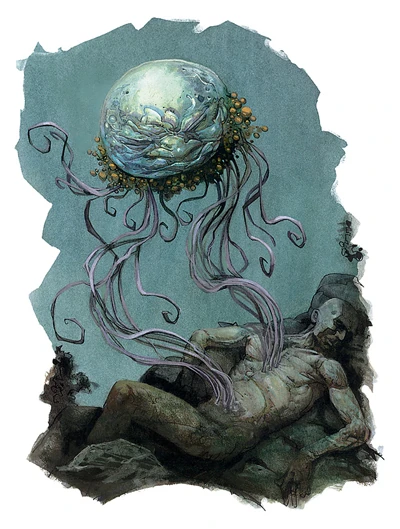
#cw gore#cw body horror#cw mutilation#dybbuk#dnd#dnd5e#DnD 5e#d&d#smash or pass#5e#monsters of the multiverse#mpmm
28 notes
·
View notes
Text








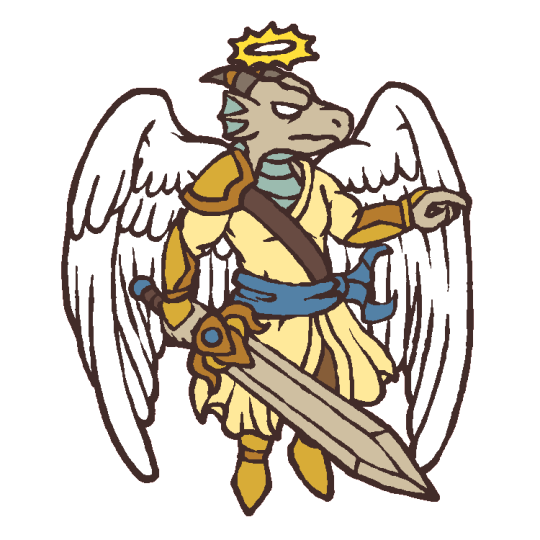

I've been drawing way more often lately, got the style right with my iPad in procreate finally. Still need GIMP 2.8 for the indexing, but sitting on the couch drawing is a lot easier than in front of the computer with a mouse like the last 2000 characters lol
#d&d#pathfinder rpg#d&d 5e#character portraits#paper minis#barghest#herbalist#mage#dybbuk#formian#locathah#hunter#solar#cloud giant#mist runner
21 notes
·
View notes
Text

the dybbuk once more
9 notes
·
View notes
Text


13 Unusual Beasts & Spirits: The Dybbuk The Dybbuk is a Kabbalic Jewish haunting spirit, the psychic remains of a person -- usually a man -- who possess a community member and drive them through manic urges towards some unfulfilled end or goal. They can be exorcised, but the only way to get rid of one without Rabbinical intervention is to let, or help the ghast accomplish its task. A Mezuzah at the door can also help turn them away. Their influence has historically served to excuse "hysteria" and mania, from people Not all of them are bent on something as wholesome as our Austrian composer here. Don't even talk to me about boxes -- I have on good authority the only thing inside is ahistorical assertion and antisemitic rumor.
7 notes
·
View notes
Text
Legendary Creatures: Ghosts
A belief in a spirit or soul that exists after a person or animal dies goes back as far as the written record and likely has origins in prehistory. Funerary practices seem to indicate a belief in the continuation of life by burying a person with objects that were used in daily life as well as practices like ritual feeding or clothing of ancestors. Since the belief in a continuation of some kind after death exists in so many cultures, we know that this belief goes far back in human history, perhaps even before modern humans expanded out of Africa. Many experts think that the awareness of mortality gave rise to a belief that some part of humans continues beyond death.
In cultures that didn't develop writing, or those whose written history was destroyed by colonizers, it's difficult to know what they believed about ghosts, spirits, or what happened to a person after death. We rely on more modern records by people who might view them as 'exotic' or might genuinely respect them and more recently by the people themselves. With that in mind, let us explore what we know about what people thought about ghosts in antiquity around the world.
Africa:
Among the Igbo people, man is both physical and spiritual in nature and the spiritual is eternal. The Akan see humans as having five parts, the Nipadua (body), Okra (soul), Sunsum (spirit), Ntoro (character from the father), and Mogya (character from the mother).

By Shyamal - Own work, Public Domain, https://commons.wikimedia.org/w/index.php?curid=5710972
The most well known in Africa is likely the Ancient Egyptian mythology because they wrote down their belief systems. They believed that a person was made of eight parts, the Khet (physical body), the Sah (spiritual body), Ren (name/identity), Ba (personality), Ka (double/vital essence), Ib (heart), Shuyet (shadow), Sekhem (power/form). The collective name for the spirit of a dead person once they entered the afterlife is the Akh. This idea was likely well developed early in the Old Kingdom (2700-2200 BCE). One of the ceremonies performed by priests after death, which was thought to happen when the Ka left the body, was to open a person's mouth to release the Ba to join the Ka, which creates the ꜣḫ (akh).
The afterlife was thought to be like the the mortal life but more resembling the journey of the Sun as it descended into Duat (underworld), meeting the mummified body of Osiris. Often, the mummified body was addressed as 'Osiris'. The ba, depicted as a featureless shadow as it left the body at dawn, would go about its work during the day and return to the body at night, as they believed the Sun returned to Osiris at night. Those who completed some form of quest or task were thought to become stars. The Book of the Dead, which was called the Book of Going Forth by Day by the Ancient Egyptians laid out how to avoid a second, permanent death. As written in the tomb of Nekhen of the Eighteenth Dynasty had written on his tomb as translated by James Peter Allen, American Egyptologist, 'Your life happening again, without your ba being kept away from your divine corpse, with your ba being together with the akh … You shall emerge each day and return each evening. A lamp will be lit for you in the night until the sunlight shines forth on your breast. You shall be told: "Welcome, welcome, into this your house of the living'.
During the Twentieth Dynasty (1189-1077 BCE), the idea of a roaming ghost, which could cause nightmares, guilt, or illness, began to be recorded. These arose when tombs weren't taken care of by prayers and offerings. The ghost could also be asked for benefits or to inflict punishments by making specific prayers and offerings.
As other areas of Africa didn't really have written records that we can decipher or find today, it's difficult to know what was the difference between gods and ghosts.
Mesopotamia:
Ghosts of the dead were known as gidim (𒄇) in Sumer, which became eṭemmu in Akkad. This word means something like gig (to be sick) and dim (a demon) or maybe gi (black) and dim (to approach). Sumerian is an agglutinative language, so different syllables can mean different things and were written differently and could be written differently when they were joined together and their endings were changed.

By Gennadii Saus i Segura - Own work, CC BY-SA 4.0, https://commons.wikimedia.org/w/index.php?curid=126738193
The memory and personality of the person went into the gidim, which was created at the death of the person, which then went to the Irkalla, the underworld and realm of Ereshkigal (𒀭𒊩𒌆𒆠𒃲), 'Queen of the Great Earth', goddess of the underworld with her husband Nergal (𒀭𒄊𒀕𒃲). To reach Irkalla and Anunnaki (𒀭𒀀𒉣𒈾), the gods of judgment who gave the laws of the dead and assigned fates to the dead. In addition to this, the sun god Utu would visit the neatherworld nightly and punish those who harassed the living and share offerings with the forgotten.
Offerings to dead relatives of food and drink by surviving family was said to comfort the dead. The forgotten would suffer and be able to cause physical and mental illnesses on their relatives who don't remember them if there are relatives that remain. Those who died in ways that their body was unrecoverable would have no ghost.
China:
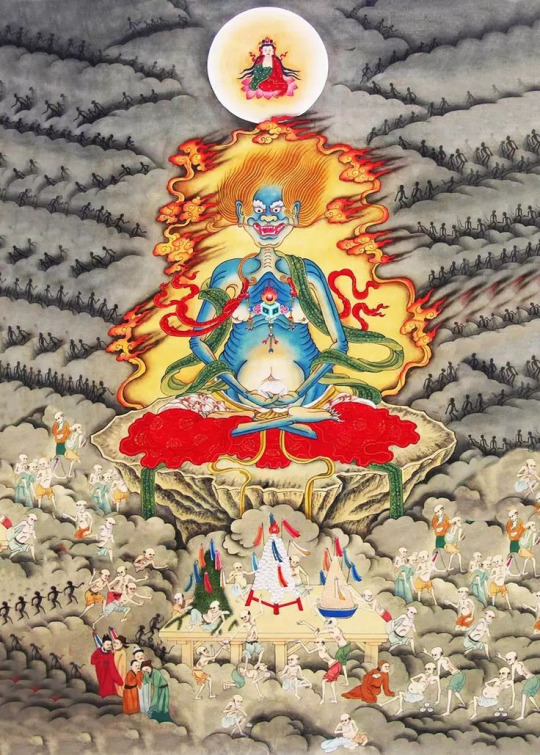
By Unknown artist, Ming Dynasty - http://www.鹿山會館.tw/EastCapital/viewthread.php?tid=419&sid=ZzXrihhttp://www.shanximuseum.com/collect/topic/shuiluhua.html, Public Domain, https://commons.wikimedia.org/w/index.php?curid=138953197
Among the Chinese, with the widespread culture of ancestor worship, they believed that ancestors could be reached through a medium for aid in many areas of life. The still celebrated Hungry Ghost Festival (Zhongyuan Festival in Taoism, Yulanpen Festival in Buddhism) is also a part of ancestor worship as it's believed that on the day of the festival, spirits are able to cross from the underworld to the mortal world. Ghosts in Chinese cultures have many terms, generally related to guǐ (鬼 in Mandarin) such as guilao (鬼佬) for a ghost man, which is used as a pejorative for foreigners. Even nightmare (魇 yǎn) is related to the idea of ghosts.
Part of the belief encompassed in ancestor worship is the concept of the spirit being comprised of yin and yang, which was called hun (魂) and po (魄). Po, the yin component, is related to the grave and hun, the yang component, is related to ancestral tablet. When the person dies, the spirit divides into three, the po component remaining with the grave, the hun component going to the ancestral tablet, and the third component goes to judgment. The hun and po components can only survive as long as they are remembered and nourished. Eventually, the hun and po move on to the underworld, a neutral place, though the hun visits heaven first. Chinese ghosts are able to affect the mortal world, even to the point of murdered people could exact revenge on those who killed them.
Taoism became the majority religion during the Han dynasty (206 BCE- 220 CE) and Buddhism during the Tang Dynasty (681-197 CE). For a long time, these two belief systems were accepted together, syncretism (the mingling of beliefs) leading to a more complex system of beliefs with the ancestor worship of Taoism and traditional Chinese religion blending together with the belief in reincarnation found in Buddhism to create something unique with ten types of ghosts, one of which, the hungry ghosts (饿鬼, èguǐ), can be further divided into nine types.
Mediums were called mun mai poh (simplified 問米, traditional 問覡) which means 'ask rice woman' and is a pun for 'spirit medium' with different inflections. because the people coming to her would bring a cup of rice from their home so the ghosts could find and identify their family members. The medium helps to find out what the ancestor needs for the family's request (winning the lottery or getting into government housing). These needs are then burnt as paper effigies.
Japan:
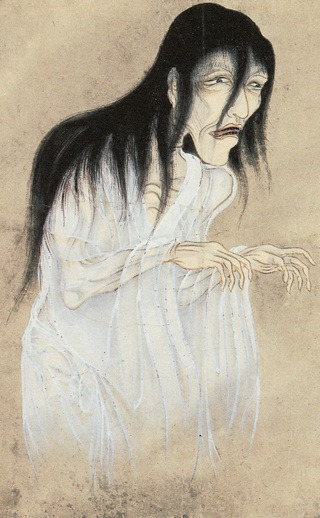
By Sawaki Suushi (佐脇嵩之, Japanese, *1707, †1772) - scanned from ISBN 4-3360-4187-3., Public Domain, https://commons.wikimedia.org/w/index.php?curid=5510196
Japan's concept of a spirit or a soul is called a reikan (霊魂) that enters a holding place until they recieve a proper funeral and funerary rites so they can then join their ancestors. Those who are murdered, die of suicide, don't have a proper burial, or are consumed by revenge, love, jealousy, hatred, or sorrow, the reikan becomes a yuurei (幽霊 meaning faint or dim soul or spirit), which can interact with the physical world if they are fueled by strong enough emotion. These spirits remain until proper rites are performed for them or they are able to resolve their emotional issue. The yuurei tend to haunt only at the 'midtime of the hours of the Ox', which is 2:00-2:30am and tend to be bound to certain locations.
Another type of ghost, one who had stronger emotions and are capable to causing physical harm in the mortal world, is the onryou (怨霊) which means 'vengeful spirit' (alternately wrathful, hatred, resentful, ruthless, envious, dark, fallen, or downcast). There are three notable people who became onryou so revered that they became known as the Three Great Onryou of Japan (日本三大怨霊), Emperor Sutoku (July 7,1119-September 14,1164), Taira no Masakado (early 900s-March 25, 940), and Sugawara no Michizane (August 1, 845-March 26, 903) who reportedly caused a lot of death and destruction after their deaths because of the resentment and anger they died with. They were elevated to kami (gods) and a Shinto shrine in an effort to appease them.
India:

By Roboture - Own work, CC BY-SA 3.0, https://commons.wikimedia.org/w/index.php?curid=18747046
In India, the Sanscrit word bhoota (भूत) usually referred a to the ghost of a deceased person. Exactly what they are, though, varies by region, community, and time period. They are usually seen as those who were too hung up on something that keeps them from moving on through to the next phase in existence, which also varies by tradition. The belief in bhootas is an important and deeply ingrained part of the culture of the Indian subcontinent
Bhootas avoid touching the earth because the earth is held to be either sacred or semi-sacred, have feet that face backwards, are able to shape-shift though they tend to be human shaped most of the time, cast no shadows, and speak with a 'nasal twang'. There are some bhoota that haunt houses, which then become 'bhoot bangalas' (bhoot bungalows), usually where they died or are emotionally attached to. Stories with bhootas in them tend to select the traits to create the most suspense. Bhootas are capable of haunting milk, to the point of seeking it out. If someone drinks that milk, they can become possessed, which is another frequently used trope in the stories.
To protect themselves, people could use water, iron, or steel at hand since bhoota fear these things, as well as the scent of brunt tumeric, the fibers of an herb called bhutkeshi (bhoota's hair), holy figures, and the sprinkling of dirt.
Kingdom of Israel and Judah and diaspora:

By Ephraim Moses Lilien (1874–1925) - Book of Job, appearing in Die Bucher Der Bibel, Public Domain, https://commons.wikimedia.org/w/index.php?curid=19447366
In the Hebrew Bible, there is a type of ghost called the owb (אוֹב) that's mentioned a few places. It relates to both mediums, with their connection to the dead and necromancy, such as when King Saul consults with the Witch of Endor to summon the spirt of Samuel, the prophet. Other places, it relates to shades, the spirits of those in the underworld.
In Jewish mythology and folklore, there is another type of ghost, that called in Yiddish a dybbuk (דיבוק), which comes from the Hebrew verb dāḇaq (דָּבַק), which means 'to cling' or 'to adhere'. These spirits are believed able to possess someone and to be the soul of a dead person. This type of ghost is first written of in the 16th century. The mezuzah (מְזוּזָה a specially inscribed parchment kept at doorways) is supposed to protect against dybbuk, a well hung one actually preventing a dybbuk from forming.
Greece:

By Eumenides Painter - User:Bibi Saint-Pol, own work, 2007-07-21, Public Domain, https://commons.wikimedia.org/w/index.php?curid=2453109
The ancient Greeks viewed ghosts 'as a vapor, gibbering and whining into the earth' as Homer wrote in the Odyssey and Iliad in the 8th century BCE. By the 5th century BCE, in classical Greece, ghost became something that could haunt people or places, for either good or ill, and were capable of interacting with the mortal world. They also performed ceremonies and sacrifices, including the pouring out of drinks, to make sure the spirits of the dead, which they viewed as shades, would not return to haunt their families. Shades (σκιά) were usually the spirit of the dead in the underworld and could be speak through oracles and could have divinity confirmed on them, like the Oracle of Ammon did to Hephastion, 'by far the dearest of all the king's friends' when Alexander the Great was 'inconsolable' after he died.
Rome:

By Henry Justice Ford - http://www.postershowcase.info/i1862812.html, Public Domain, https://commons.wikimedia.org/w/index.php?curid=11733112
Ancient Romans saw ghosts as a method of revenge by way of a curse being written on pottery or lead placed in a grave. They believed that ghosts could haunt locations, such as when Pliny the Younger wrote around 50 CE about the Stoic Athenodorus (who lived 100 years earlier) renting a house in Athens that was haunted. He deliberately sat up writing late. He saw a ghost wrapped in chains, which he then followed outside until the ghost pointed out a particular site. Athenodorus excavated the location and found a skeleton bound in chains. Once the skeleton was buried properly, the haunting ended.
One of the first skeptics to write their lack of belief was Lucian of Samosata, who wrote in the 2nd century CE. He wrote about Democritus (who lived about three hundred years earlier) lived outside the city of Abdera in Thrace deliberately to prove that ghosts didn't exist, even in the face of practical jokes, such as the young men of the city dressing up in 'black robes with skull masks'.
Central America:
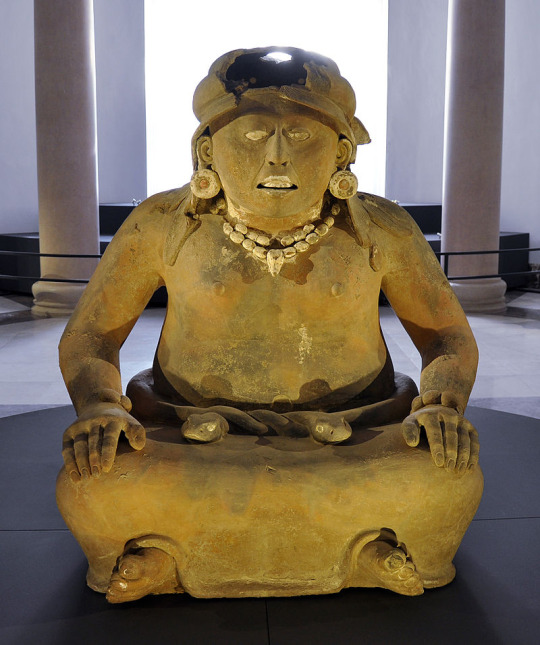
By Vassil - Own work, CC0, https://commons.wikimedia.org/w/index.php?curid=17841631
Aztecs believed that after death the soul moved on to one of three places, Tlālōcān (a Paradise reigned over by the rain deity Tlāloc), Mictlān (where the dead travel with Xolotl through nine levels, passing several challenges) and the Sun. Fallen warriors and women who died in childbirth became hummingbirds.
The Maya believed in a pair of collective ancestors, the '(grand)fathers and (grand)mothers' which inhabited particular mountains where offerings were meant to be given.
The Purépecha believed that monarch butterflies symbolized the movements of the dead to their afterlife as they migrated to their winter habitat in what is now Michoacán, near where they lived. Theyalso had a story of the ghosts of a princess Mintzita and her fiancé go to a particular cemetary every Noche de Muertos as the Spanish called it. On that night, now, people float candles on Lake Pátzcuaro as well as others. Michoacán is even now called el alma de Mexicho (the soul of Mexico).
#ghosts#ghost#ancient egypt#igbo#afterlife#akh#gidim#gui#guilao#reikan#yuurei#onryou#bhoota#owb#dybbuk#shades#ancestor worship#legendary creature
4 notes
·
View notes
Text
10 Gripping Facts about Dybbuks from Jewish Folklore

You’ve likely heard of ghosts and demons, maybe even wish-granting djinns. But how about soul-cleaving dybbuks? These evil spirits are rooted in Jewish folklore and rank high among the most dangerous supernatural beings due to a monstrous propensity for human possession. Fear of the dybbuk reached an all-time high between the 16th and 18th centuries, and though it has died down in the years following, some still consider them a threat.
Whether stories of the dybbuk initially served as a horrifying reminder to act rightly, explain troubling behavior, or warn of a real-life danger—or a combination of all three—one thing is sure. These terrifying creatures are the stuff of nightmares. Keep reading for more on these ancient phantoms of lore...
Listverse
7 notes
·
View notes
Link
Have you heard of Dybbukim?
137 notes
·
View notes
Text
Film-related stuff from my Redbubble shop


PRODUCTS FEATURING SMOKE SIGNALS COLLAGE


PRODUCTS FEATURING VICTIM (1961) COLLAGE


PRODUCTS FEATURING THE LION IN WINTER VALENTINE


PRODUCTS FEATURING FLORIDA NOIR


PRODUCTS FEATURING POSSESSION BY HANA THE DYBBUK


PRODUCTS FEATURING MARLENE'S SEWING CIRCLE


PRODUCTS FEATURING WHAT'S MY LINE? - FRED ASTAIRE
#Film#cinema#Smoke Signals#Victim#Dirk Bogarde#The Lion in Winter#Katharine Hepburn#Peter O'Toole#Film Noir#Noir#Horror#Jewish Folklore#Dybbuk#Marlene Dietrich#LGBTQ History#LGBT History#Queer History#Lesbian#Queer#Bisexual#Fred Astaire#What's My Line#my art#my redbubble designs
2 notes
·
View notes
Text
The Thaumaturge
because I just love this game^^ (and the salutors look so beautiful and mesmerising)







#the thaumaturge#wiktor szulski#thaumaturge wiktor#rasputin#thaumaturge rasputin#demons#temperomancer#i love this game#salutors#dybbuk#veles#morana
6 notes
·
View notes
Text

Sekt | Expiate In Purgatory | 2023
Australian Black Metal
A homage to 90's Australian Black Metal featuring Ex members of Tyrant, Dybbuk, Samain & Pagan.
#Sekt#Expiate In Purgatory#Australian Black Metal#Black Metal#Raw Black Metal#music#band#Tyrant#Dybbuk#Samain#Pagan#Louis Rando#The Furor#Impiety#Mhorgl#Depravity#Bandcamp
13 notes
·
View notes
Text

On the left, the Meazel! In 5e these are hermits who went to the shadowfell to contemplate their misery. 4‒5 ft (1.2‒1.5 m) teleporting creatures who specialize in strangling via garotte. Despite the name and diseased appearance, they're actually non-contagious outside blood-to-blood contact. They're sadists and solitary, but mating is one of the few things that can get them to seek out others, so you're probably safe here!
On the right...ok, this isn't actually the Dybbuk's real form. They're demons that possess corpses, their real form is a telepathic jellyfish demon that loves making people scared or nauseous. They try to spend all thier time in the prettiest corpses they can find, entirely so they can freak people out by mutilating it (then fixing it up to do it again).
#meazel#dybbuk#cw bones#cw body horror#cw blood#cw gore#cw corpse#5e#dnd5e#DnD 5e#D&D 5e#mpmm#smash or pass
14 notes
·
View notes